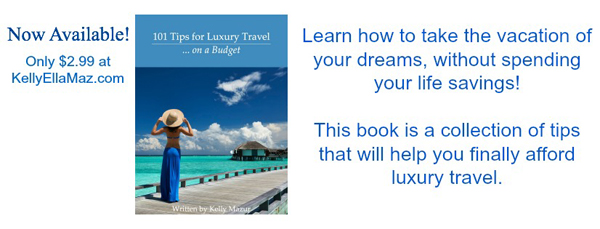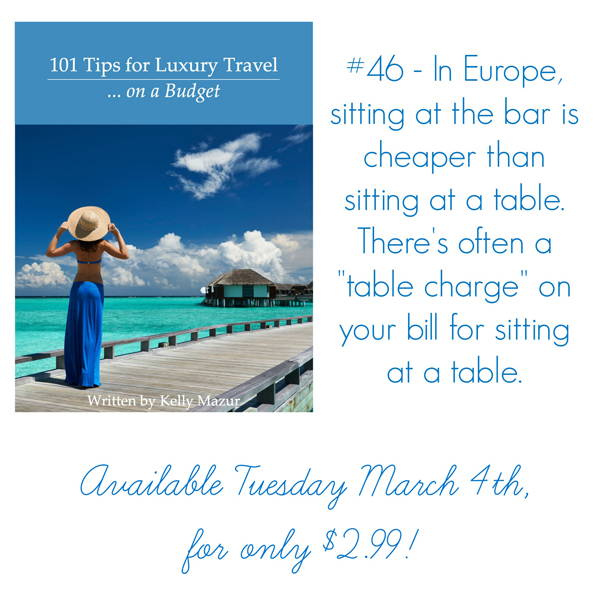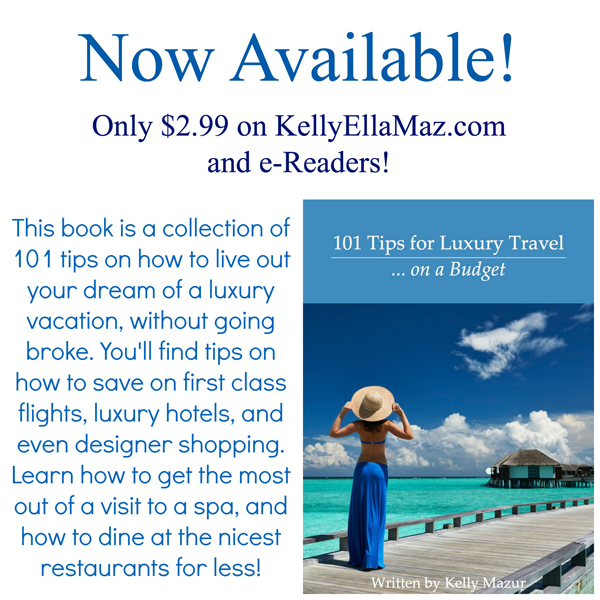
eBook © by goXunuReviews (Flickr)
After reading How to Write a Super Sexy eBook in 2 Days Without Losing Your Mind, I instantly knew that writing an eBook would be a great learning experience, and hopefully, a new source of income.
As a travel blogger, I had writing experience, but had never compiled my writing into an eBook.
I also loved that writing an eBook would cost nearly nothing, except my time.
With plans to move to Barcelona, I needed to increase the income from my website to support myself.
Here’s my case study on the pros (and cons) of writing an eBook…
Choosing a Topic
When choosing an eBook topic, I thought long and hard about what sets me apart from other travel bloggers and what valuable information I could provide. Plus, the eBook needed to be something people would want to pay to learn about.
Luckily, my “type” of travel fell into a somewhat unique category. I have very expensive taste and high standards when it comes to travel. Some might even put me into the “Luxury Travel” category… except there’s a twist!
I’m a total fraud!
I don’t have thousands of dollars to spend on travel. In addition to travel blogging, I work as a receptionist and have been paying for night school the past four years! The only reason I can afford to go on multiple “luxury” vacations per year is because I have a personal collection of tricks and tips to score amazing deal!
After this realization, the title (and theme) of my eBook was born: 101 Tips for Luxury Travel… On a Budget.
Writing
My first task was to compile a list of 101 tips for luxury travel.
To refresh my memory, I walked through the steps of planning a trip and wrote down all the things I do to cut costs:
- How do I get cheap flights?
- Where do I look for inexpensive accommodations?
- How do I save money sightseeing?
It took me about a week to finalize the list.
Then, I broke the tips into categories like transportation and accommodation. It took me another two weeks to finish writing the author bio, introduction and chapter introductions. I tried to write for 30 minutes a day, and increased that to two hours per day on weekends.
My chapter introductions were one to three sentences, and most of the tips were one sentence which really cut down on writing time because there’s significantly less content in my eBook than a novel. I wanted to create an eBook that would really help people save money, so I made it an easy read, full of great advice. The final result was an eBook of expert advice on finding inexpensive luxury travel.
Formatting
To format the eBook, I used Microsoft Word’s publishing layout because I’m proficient with the advanced tools. However, formatting the eBook into an attractive layout was the most time consuming part of the whole process.
I designed my own template from scratch, using a combination of text boxes, lists, and pictures.
Choosing the pictures was a challenge. They needed to be high quality, professional, and my own - which limited my selection. (View Formatting Sample in PDF)
I used both text and image formatting to increase the perceived value and lengthen the eBook.
However, this format didn’t meet the Kindle Direct Publishing and iBooks guidelines which significantly limited my customer base. Looking back, I would have formatted the book to meet their guidelines (avoiding images and text boxes) in order to maximize sales.
Designing the Cover
They say “never judge a book by its cover,” but everyone judges a book by its cover so it’s an important step in convincing a person to buy.
My eBook cover needed to stand out and look good as a small thumbnail image for mobile devices.
I wanted to use a background image for my cover and found it by searching “luxury travel” on Shutter Stock. I bought the image rights for around $10, so I had a professional backdrop without breaking the bank.
Once I had my cover image, I added a text box for the title, and one for my name. I used a solid color behind the title in order for it to stand out. Again, I really wanted my cover to look clear on any size device so I kept things simple and went for a very clean design.

Writing an eBook: Cover
Selecting a Market Place
I spent a few weeks researching platforms to sell my eBook.
Selling the eBook on my website meant that I could keep 100% of the profits, but it limited the customer base to only my own readers.
As I mentioned before, platforms such as Kindle Direct Publishing and iBooks have restrictions, such as:
- iBooks requires a US Tax ID and eBooks can only be submitted in .ibooks or EPUB formats.
- Kindle Direct Publishing doesn’t allow text boxes and/or images.
With Kindle Direct Publishing your customer base is all of Amazon and Kindle readers. Once you upload your eBook onto their site, you’re eBook will display in their search results - resulting in a MUCH larger audience than just your blog readers. However, you make 30% less money per book. Kindle credits your account with 70% of the book sale and keeps the remaining 30% for their services. So you reach more customers, but make less per book.
After extensive research, I selected two places to sell my book:
- My website kellyellamaz.com: I created a new page in WordPress, uploaded a PDF copy of my eBook, added a PayPal checkout button, and was good to go.
- Kindle Direct Publishing: I created a quick text-only version of my eBook and uploaded a PDF copy to Kindle Direct Publishing.
I’ve had only one sale from Kindle Direct Publishing, and the rest have been on my website. I’m really unhappy with the text-only version of the book because it really lacks character. I will leave this version up for another month, but I eventually plan to remove it from Kindle.
Pricing
When determining a selling price for my eBook, I thought about my ultimate goals:
- To make money AND
- Reach new (and future) readers.
So, I chose to price my book at a reasonable price of $2.99 USD. I’m confident that once someone reads my eBook, they’ll follow my blog as well!
Tools
The only two tools I used to complete my book were Microsoft Word and PayPal.
In Microsoft Word, I used the “publishing layout.” Although I chose to create my own layout, there are plenty of templates to help you get started. The .doc document was incredibly easy to convert to PDF and the overall appearance of my book was exactly the quality I wanted. Using Microsoft Word gave me complete control over the appearance of my book.
I used PayPal to receive eBook payments on my website. In WordPress, I created two pages:
- Selling Page: After creating a “Buy Now” button on PayPal, I pasted the embed code (provided by PayPal) into my selling page. When someone buys my eBook, PayPal will automatically redirect them to the download page.
- Downloading Page: I uploaded my eBook to WordPress and created a link on the downloading page.
Promotion
Writing my eBook was only half the battle. Promotion was just as important. I determined three different “campaigns” to help spread the word:
- Social media campaign
- Media campaign
- Family campaign
The first thing I did was put together a “social media campaign” which consisted of custom Facebook cover photos, perfectly square ads for Instagram, and pre-written tweets to be released every couple of days. I created (and finished) all of my “ads” and messages three weeks before my eBook release. I had them organized on my computer, and ready to be posted in the two weeks leading up to my book release.

Writing an eBook: Facebook Promotion

Writing an eBook: Instagram Ad

Writing an eBook: Instagram Ad
I receive most of my traffic from these social media postings, which resulted in nearly 70% of my book sales. I believe these social media messages are how the majority of my readers, friends, and family discovered that my book had been released and was available for purchase.
For my “media campaign“, I contacted travel bloggers and companies informing them about my eBook and my availability for interviews. Unfortunately, I found that many bloggers showed interest in featuring my book (in exchange for a free copy) but very few actually followed up. After looking back at the emails I sent to fellow bloggers, I realized that using the same template for everyone made my emails sound very scripted and impersonal. I think more bloggers would have been interested in working together if I made more of a personal connection with them.

Writing an eBook: Email Outreach
On a positive note, I scored five interviews on different travel blogs where I discussed my website and eBook launch. My goal with this campaign was to reach targeted traffic. Although the interviews were successful, I should have offered more incentives to bloggers in order to receive features and write-ups. Offering free copies for giveaways might have been a better incentive for potential features. I found some websites also charged a fee for such features, and that may have been an affordable way to advertise my book directly to travel fans.
Lastly, I launched a “family campaign” and emailed all of my family and friends a PDF with the eBook image cover, description, and sample of travel tips (See Friends and Family Promotion PDF). I also posted it at my office, handed out copies at a café I frequent daily, and asked my friends and family to forward the message.
Income and Results
The first two days had steady sales. Within the first hour, I had already made back the $10 I had spent on the cover image.
Since this was my first eBook, I knew it would be more of a learning experience than a money maker. So when sales died off after a few days, I experimented with different advertising methods.
I “boosted” my eBook announcements on Facebook to reach a larger audience, which resulted in few sales.
I teamed up with another travel blogger who gave me five free copies of her eBook to use as a joint promotion. I quickly announced that any weekend purchases of my eBook would be entered to win a free copy of her travel book, and my book sales spiked again. Unfortunately, after the weekend they dropped.
It’s been almost two months since the release of my book and I’ve earned $50.
Lessons Learned
My next eBook is already in process, but this time I will try a couple different strategies, including:
- Ensuring it complies with the Kindle Direct Publishing and iBooks requirements to reach a larger audience;
- Spending more time developing a promotional strategy;
- Pitching fellow travel bloggers using more personal notes; and
- Writing a longer eBook to offer more valuable content.
Pros of Writing an eBook
For me, there have been many pro of writing an eBook which include:
- Learning the ins and outs of creating, selling, and promoting an eBook;
- Having a tangible product that I’m extremely proud of;
- Earning passive income for years to come without any additional work;
- Receiving nothing but positive feedback from my readers;
- Sharing my writing with a new audience;
- Developing long-term relationships with fellow travel bloggers; and
- Learning new marketing strategies that I can apply to other areas of my business.
Cons of Writing an eBook
Here are some cons of writing eBook:
- Spending a significant amount of time writing, formatting, promoting, and researching how to sell an eBook;
- Feeling the roller-coaster of emotions with the highs and lows of sales; and
- Losing the opportunity to work on other areas of the business (e.g. publishing articles, marketing, etc.)
Overall Advice
For me, I consider this eBook to be a success because I learned a great deal about writing, selling, and promoting an eBook. I’ve made $50 in sales (and counting) and have a tangible e-product that I can sell for years to come without any additional work. If sales continue, I’ll be on target to make $300 passive income from eBook sales.
Overall, I would recommend writing and selling an eBook. With virtually no money spent, and a little bit of your time, you can create a product that can be sold for years to come.
It is a fantastic learning experience with endless opportunities. Who knows, you might even get picked up by a publisher!

Kelly Mazur
Have you written an eBook?
Share your advice and feedback below…
###
About the author: Kelly Mazur is a personal travel planner and travel writer. She finds ways to stretch her annual budget (and sometimes her credit limit) to enjoy at least three luxury vacations per year. Over the last few years she’s collected tips to help her afford to see more of the world, for less money. Follow Kelly and her luxury travel on http://kellyellamaz.com, Facebook, and Twitter.
Hi to every , for the reason that I aam in fact keen of
reading this website’s post to be updated on a regular basis.
It cpntains pleasant information.
thanks for the article, good information and maybe will try it. jackie
Hi Kelly
Thanks for the tips which I find really useful and
interesting! I am going to sign up to your website
rightaway !
I just joined the academy so will get back after I have
tried some of the ideas 🙂
I already have 2/3 questions though!
1. Publishing:
A.
You did make a text only version for Kindle Books; so
why do you list that under ‘differrntly next time’?
Do you mean a different type of text formatting?
B.
Why dont you want to do iBooks - this tme nor
the next time?
2. Pricing:
Would there have been a significant sales drop if
you had made the Price higher - say $4.99?
Thanks again for the great tips & I look forward to
connecting further.
Have a great 2015!
Cheers !
Renuka
Hi Renuka - thank you for your kinds words!
The academy is run by Adam, not me - but I cannot recommend it enough! It is incredibly valuable and I think I’m going to go through it a second time.
To answer your questions…
1. A) Because I made my book, then researched how to sell it (instead of the other way around) I created a beautiful image-focused book that I couldn’t sell on a Kindle. I regretted not doing my research first because it would have drastically changed how I formatted the entire book. The text-only version that I made for Kindle was sub-par in my opinion, and I eventually took it down because I didn’t feel it was a high enough standard.
Because of the style of my book, there actually wasn’t a ton of text. It was an easy-to-read list of tips that really relied on images.
B) Apple’s iBooks is even stricter to sell on when it comes to layout. I would consider using them for a book that is, let’s say, a story of my travel life. But I would not use them for a travel guide or anything else that is less text and a fair amount of images.
** To this day, over a year later, I have made more money selling my eBook in it’s colourful, image-filled version on my own site than I have on any other platform.
2. I have since raised my price to $3.99 and have not noticed a decrease in sales (not that monthly sales were very high to begin with).
My advice. WRITE YOUR BOOK. Get it out there! Just know that it *might* not be a huge money maker, but it’s a great learning experience and book #2 will have a lot of potential. A lot of the same things I learned from writing and selling an eBook can also be applied to grew